Sten
The STEN (or Sten gun) was a family of British submachine guns chambered in 9×19mm and used extensively by British and Commonwealth forces throughout World War II and the Korean War. They had a simple design and very low production cost, so they were also effective insurgency weapons for resistance groups.
| Sten, submachine gun | |
|---|---|
 Sten MK II | |
| Type | Submachine gun |
| Place of origin | United Kingdom |
| Service history | |
| In service | 1941–1960s (United Kingdom) |
| Used by | See Users |
| Wars | World War II Warsaw Uprising Second Sino-Japanese War Chinese Civil War Indonesian National Revolution[1] First Indochina War Indo-Pakistan Wars 1948 Arab–Israeli War Malayan Emergency Korean War Mau Mau Uprising[2] Algerian War[3] Suez Crisis Sino-Indian War Vietnam War Indonesia–Malaysia confrontation[4] Laotian Civil War Biafran War[5] Bangladesh Liberation War[6] Lebanese Civil War Angolan Civil War Rhodesian Bush War Turkish invasion of Cyprus IRA Border Campaign The Troubles Punjab insurgency Iraq War[7] Syrian Civil War |
| Production history | |
| Designer | Major Reginald V. Shepherd Harold J. Turpin |
| Designed | 1940 |
| Manufacturer | Royal Small Arms Factory Enfield BSA ROF Fazakerley ROF Maltby ROF Theale Berkshire Lines Brothers Ltd Long Branch Arsenal Canada (plus numerous sub-contractors making individual parts) Various underground resistance group factories |
| Produced | 1941– (version dependent) |
| No. built | 3.7–4.6 million (all variants, depending on source) |
| Variants | Mk. I, II, IIS, III, IV, V, VI Unit Cost $10 or £2.3 in 1942 (equivalent to $154 or £106 in 2018) |
| Specifications | |
| Mass | 3.2 kg (7.1 lb) (Mk. II) |
| Length | 762 mm (30.0 in) |
| Barrel length | 196 mm (7.7 in) |
| Cartridge | 9×19mm Parabellum |
| Action | Blowback-operated, open bolt |
| Rate of fire | version dependent; ~500–600 round/min |
| Muzzle velocity | 365 m/s (1,198 ft/s) 305 m/s (1,001 ft/s) (suppressed models) |
| Effective firing range | 100 m |
| Feed system | 32-round detachable box magazine |
| Sights | fixed peep rear, post front |
STEN is an acronym, from the names of the weapon's chief designers, Major Reginald V. Shepherd and Harold Turpin, and EN for Enfield.[8][9] Over four million Stens in various versions were made in the 1940s.
History
The Sten emerged while Britain was engaged in the Battle of Britain, facing invasion by Germany. The army was forced to replace weapons lost during the evacuation from Dunkirk while expanding at the same time. Prior to 1941 (and even later) the British were purchasing all the Thompson submachine guns they could from the United States, but these did not meet demand. American entry into the war at the end of 1941 placed an even bigger demand on the facilities making Thompsons. In order to rapidly equip a sufficient fighting force to counter the Axis threat, the Royal Small Arms Factory, Enfield, was commissioned to produce an alternative.
The credited designers were Major R. V. Shepherd, OBE, Inspector of Armaments in the Ministry of Supply Design Department at The Royal Arsenal, Woolwich, (later Assistant Chief Superintendent at the Armaments Design Department) and Mr. Harold John Turpin, Senior Draughtsman of the Design Department of the Royal Small Arms Factory (RSAF), Enfield. Shepherd had been recalled to service after having retired and spending some time at the Birmingham Small Arms Company (BSA).
The Sten shared design features, such as its side-mounted magazine configuration, with the Royal Navy's Lanchester submachine gun, which was a copy of the German MP28. In terms of manufacture, the Lanchester was entirely different, being made of high-quality materials with pre-war fit and finish, in stark contrast to the Sten's austere execution. The Lanchester and Sten magazines were even interchangeable (though the Lanchester's magazine was longer with a 50-round capacity, compared to the Sten's 32-round capacity).
The Sten used simple stamped metal components and minor welding, which required minimal machining and manufacturing. Much of the production could be performed by small workshops, with the firearms assembled at the Enfield site. Over the period of manufacture the Sten design was further simplified: the most basic model, the Mark III, could be produced from five man-hours of work. Some of the cheapest versions were made from only 47 different parts. It was distinctive for its bare appearance (just a pipe with a metal loop for a stock), and its horizontal magazine. The Mark I was a more finely finished weapon with a wooden foregrip and handle; later versions were generally more spartan, although the final version, the Mark V, which was produced after the threat of invasion had died down, was produced to a higher standard.
The Sten has been described by Max Hastings as: "highly unreliable, prone to jamming, and inaccurate beyond 30 metres. It was unsuitable for guerrilla operations in open country because it encouraged waste of ammunition. But it was easy and cheap to produce, a gun was said to cost fifteen shillings (three quarters of a pound), and was supplied to the (French) Resistance in huge quantities".[10]
The Sten underwent various design improvements over the course of the war. For example, the Mark 4 cocking handle and corresponding hole drilled in the receiver were created to lock the bolt in the closed position to reduce the likelihood of accidental discharges inherent in the design. Most changes to the production process were more subtle, designed to give greater ease of manufacture and increased reliability. Build quality ranged from quite good (Canadian production) to poor (early British production.) Sten guns of late 1942 and beyond were, in general, highly effective weapons, though complaints of accidental discharge continued throughout the war.
The Sten was replaced by the Sterling submachine gun from 1953 and was gradually withdrawn from British service in the 1960s. The other Commonwealth nations made or adopted their own replacements.
Design
The Sten was a blowback-operated submachine gun firing from an open bolt with a fixed firing pin on the face of the bolt. This means the bolt remains to the rear when the weapon is cocked, and on pulling the trigger the bolt moves forward under spring pressure, stripping the round from the magazine, chambering it and firing the weapon all in the same movement. There is no breech locking mechanism, the rearward movement of the bolt caused by the recoil impulse is arrested only by the mainspring and the bolt's inertia. The basic operating principles were similar to those of the German MP40, Russian PPSh-41, US M3 submachine gun and numerous other designs. These shared similar attributes and faults; they were simple and cheap to manufacture, and put an automatic weapon into the hands of soldiers, greatly increasing the short-range firepower of the infantry, especially when the main infantry weapon was a bolt-action rifle capable of only around 15 rounds per minute and not suited for short-range combat. However, the open-bolt firing mechanism, short barrel, and use of pistol ammunition severely restricted accuracy, with an effective range of around 100m.
Stoppages could occur for a variety of reasons: some as a result of poor maintenance, while others were particular to the Sten. Carbon buildup on the face of the breech[11] or debris in the bolt raceway could cause a failure to fire, while a dirty chamber could cause a failure to feed.[12] Firing the Sten by grasping the magazine with the supporting hand tended to wear the magazine catch, altering the angle of feed and causing a failure to feed – the correct method of holding the weapon was as with a rifle, the left hand cradling the fore piece, as per the picture of Winston Churchill firing one below.
Additional problems stemmed from the Sten's magazine, which was a direct copy of the one used in the German MP-38, originally in order to facilitate the use of German 9 mm magazines.[13] Unfortunately, this decision necessarily incorporated the Erma magazine's faults in the process. The magazine had two columns of 9 mm cartridges in a staggered arrangement, merging at the top to form a single column. While other staggered magazines, such as the Thompson, fed from both the left and right side alternately (double-column, double feed), the Sten magazine, like the MP38, required the cartridges to gradually merge at the top of the magazine to form a single column (double column, single feed). As a consequence, any dirt or foreign matter in this taper area could cause feed malfunctions. Additionally, the walls of the magazine lip had to endure the full stresses of the rounds being pushed in by the spring. This, along with rough handling could result in deformation of the magazine lips (which required a precise 8° feed angle to operate), resulting in misfeeding and a failure to fire.
Modern 9 mm magazines, such as those used by the Sterling SMG, are curved and feed both sides to avoid this problem. If a Sten failed to feed due to jammed cartridges in the magazine, standard practice to clear it was as follows: remove magazine from Sten, tap the base of the magazine against the knee, re-insert magazine in Sten, then recocking the weapon and firing again as normal.[12] To facilitate easier loading when attempting to push the cartridges down to insert the next one, a magazine filler tool was developed and formed part of the weapon's kit.
The slot on the side of the body where the cocking knob ran was also a target of criticism, as the long opening could allow foreign objects to enter. On the other hand, a beneficial side-effect of the Sten's minimalist design was that it would fire without any lubrication.[12] This proved useful in desert environments such as the Western Desert Campaign, where lubricating oil retained dust and sand.
The open bolt design combined with cheap manufacture and rudimentary safety devices also meant the weapon was prone to accidental discharges, which proved hazardous. A simple safety could be engaged while the bolt was in the rearwards (cocked) position. However, if a Sten with a loaded magazine, with the bolt in the closed position, was dropped or the butt was knocked against the ground, the bolt could move far enough rearward to pick up a round (but not far enough to be engaged by the trigger mechanism) and the spring pressure could be enough to chamber and fire the round. The Mk 4 cocking handle was designed to prevent this by enabling the bolt to be locked in its forward position, thereby immobilising it. Wear and manufacturing tolerances could render these safety devices ineffective.
Variants
Sten guns were produced in several basic marks (though the Mk I saw limited service, and the Mk IV was never issued), and nearly half of the total produced were Mark II versions. Approximately 4.5 million Stens were produced during the second world war.
Mark I
The first ever Mk I Sten gun (number 'T-40/1' indicating its originator Harold Turpin, the year 1940 and the serial number "1") was handmade by Turpin at the Philco Radio works at Perivale, Middlesex during December 1940/January 1941. This particular weapon is held by the historical weapons collection of the British Army's Infantry and Small Arms School Corps in Warminster, Wiltshire.[14]
The first model had a conical flash hider and fine finish. It had a wooden foregrip and forward handle (sometimes this was made of steel), as well for a section of the stock. The stock was a small tube outline, rather like the Mark II Canadian. One unique feature was that the front pistol grip could be rotated forward to make the firearm easier to stow. The barrel sleeve extended all the way to the end, where it met the flash hider. Along the top of the tube surrounding the barrel was a line of small holes and its sights were configured somewhat differently. About 100,000 were made before production switched to the Mark II. Sten Mk I's in German possession were designated MP 748(e), the 'e' standing for englisch.
Mark I*
This was the first simplification of the Mk I. The foregrip, the wooden furniture and the flash hider were removed for production expediency.[15]
Mark II
The Mark II was the most common variant, with two million units produced. It was a much rougher weapon than the Mk I. The flash eliminator and the folding handle (the grip) of the Mk I were omitted. A removable barrel was now provided which projected 3 inches (76 mm) beyond the barrel sleeve. Also, a special catch allowed the magazine to be slid partly out of the magazine housing and the housing rotated 90 degrees counter-clockwise (from the operator's perspective), together covering the ejection opening and allowing the weapon and magazine both to lie flat on its side.

The barrel sleeve was shorter and rather than having small holes on the top, it had three sets of three holes equally spaced on the shroud. To allow a soldier to hold a Sten by the hot barrel sleeve with the supporting hand, an insulating lace-on leather sleeve guard was sometimes issued.[16] Sten Mk II's in German possession were designated MP 749(e), the "e" signifying "englisch". Some Mk IIs were fitted with a wooden stock as this part was desirable and interchangeable with the Mk V. Also, the Spz-kr assault rifle uses the receiver and components from the Sten Mk II.
Regular Mark II:
- Overall length: 762 mm (30.0 in)
- Barrel length: 197 mm (7.8 in)
- Weight: 3.2 kg (7.1 lb)
Mark II (Canadian)
During World War II a version of the Sten gun was produced at the Long Branch Arsenal in Long Branch, Ontario now part of Toronto, Ontario. This was very similar to the regular Mark II, with a different stock ('skeleton' type instead of strut type) and improved quality of manufacture. It was first used in combat in the Dieppe Raid in 1942.
The Mark II is made in China with a copy known as the M38.[17] The Chinese M38s were made in a fully automatic only configuration and not in select fire unlike the standard Mark II. The M38 was made in 9mm and 7.62 Tokarev varients.

.jpg)
Mark II:
- Overall length: 896 mm (35.3 in)
- Barrel length: 198 mm (7.8 in)
- Weight: 3.8 kg (8.4 lb)
Mark III
This simple design was the next most commonly produced after the Mark II. A result of the manufacturer Lines Bros Ltd stating it could build a modified design that was quicker and cheaper to build than the Mk II, it was a simplification of the Mk I made both in Canada and the UK. Lines Bros Ltd was the largest manufacturer. The biggest difference from the Mark II was the unification of the receiver, ejection port, and barrel shroud that now extended farther up the barrel. The barrel was fixed and the body was welded shut along the centre of the top. Captured Sten Mk IIIs in German possession were designated MP 750(e).
Mark V

Introduced in 1944, the Mk V was essentially a better-quality, more elaborate version of the Mk 2. Changes included a wooden pistol grip, a vertical wooden fore grip, a wooden stock, and a bayonet mount. There was a No4 Lee–Enfield foresight and the weapon was of better quality manufacture and finish than the Mk2 and Mk3. The Sten bandolier issued to paratroopers held seven full magazines.
Another variant of the Mk V had a swivel stock and rear sight mirror intended for firing around corners in urban warfare, similar to the Krummlauf developed by the Germans for the StG 44.
Mark VI
See suppressed models.
- Overall length: 908 mm (35.7 in)
- Barrel length: 198 mm (7.8 in)
- Weight: 4.5 kg (9.9 lb)
Suppressed models


Mk IIS and Mk VI models incorporated an integral suppressor ("silencer") and had a lower muzzle velocity than the others due to a ported barrel intended to reduce velocity to below the speed of sound; 305 m/s (1,001 ft/s). The suppressor heated up rapidly when the weapon was fired, and a canvas cover was laced around the suppressor for some protection for the firer's supporting hand.[18]
Mk IIS
The Mk IIS was, as the name suggests, a suppressed version of the Mk II. Captured examples of the Sten Mk IIS in German service were designated MP 751(e).
Mk VI
The Mk VI (or '6') was a suppressed version of the Mk V. The Mk VI was the heaviest version due to the added weight of the suppressor, as well as using a wooden pistol grip and wooden stock.
The suppressed models were produced at the request of the Special Operations Executive (SOE) for use on clandestine operations in occupied Europe, starting with the Mk IIS in 1943. Owing to their tendency to overheat, they were fired in short bursts or single shots.[19]
In addition to its use in the European Theatre, the Mk IIS saw service with clandestine units in the Southwest Pacific Area (SWPA) such as the Services Reconnaissance Department and SOE's Force 136 on operations against Imperial Japanese forces. The Sten Mk IIS was used by the Operation Jaywick party during their raid into Japanese-occupied Singapore Harbour.
The Sten Mk IIS also saw service with the Australian Special Air Service (SAS) in Vietnam.
Experimental models
Mark II (wooden butt model)
This was a standard Sten Mk.II submachine gun with a wooden butt attached in place of the wireframe steel butt used with Mk.IIs. This wooden butt model was never put into service; it is likely that this was due to the cost of producing it.
Mark II (Rosciszewski model)
This was a Sten Mk.II modified by Antoni Rosciszewski of Small Arms Ltd. The magazine was mechanically operated by the breech block movement. The trigger was split into two sections, with the upper part of the trigger offering full-auto fire and a lower part offering single shots. It was very complex in design and never fielded.
Mark II (pistol grip model)
This was a Sten Mk.II with a wireframe pistol grip, intended for use with paratroopers. It was compact but predictably uncomfortable to fire.
Model T42
This was a Sten Mk.II modified with a 5-inch barrel and folding stock, as well as a conventional pistol grip and redesigned trigger guard. It was dubbed the "T42" in prototype phases, but never entered service.
Mark III (wooden model)
This was a Sten Mk.III with a "Lanchester" type wooden body and butt, and bayonet fittings. Sling swivels were also added. It never entered service due to the costs associated with producing it.
Mark III (wooden model II)
This was a Sten Mk.III entirely encased in a wooden body, with the only external metal parts being the trigger, barrel, magazine and cocking handle. The trigger and pistol grip were in line with the magazine. The reasons for its creation are likely an experiment into increasing the comfort and handling of the weapon in freezing temperatures.
Mark IV
The Mark IV was a smaller version which did not progress beyond the prototype stage. It was near pistol-sized and it had a different configuration with a conical flash hider, a rear pistol grip, a very light stock and a much shorter barrel.
Rofsten
Developed at the Royal Ordnance Factory at Fazakerley (ROF), the Rofsten was an odd Sten prototype with a redesigned magazine feed, ergonomic pistol grip, selector switch and cocking system. The weapon was cocked by pulling the small ring above the stock. A large flash eliminator was fixed onto the barrel, and a No.5 bayonet could be fixed. It was made to a very high quality standard and had an increased rate of fire (around 900 rounds per minute). The Rofsten was made in 1944 as a single prototype and ROF wanted to submit it to trials the next year. Despite better quality there were numerous reliability problems due to the much higher rate of fire. The budget cuts prevented the modifications and this version never got beyond the prototype stage.
Foreign-built variants and post 1945 derivatives
Argentine Sten
Sten MkIIs were licence-copied in Argentina by Pistola Hispano Argentino and can be recognised with a wooden handguard in front of the trigger group. It was known as the Modelo C.4.[20] Another variant came with a pistol grip section based on the Ballester–Molina .45 pistol.[21]
Israeli Stens
Copies of the Sten Mk II and Sten Mk V were clandestinely manufactured in Tel Aviv and on various kibbutzim in 1945-48 for use with Haganah and other Jewish paramilitary groups.[17][22]
French Sten
The French "Gnome et Rhône" R5 Sten, manufactured by the motorbike and aeroplane engine manufacturer Gnome et Rhône (SNECMA), came with a forward pistol grip and distinctive wooden stock, although its greatest improvement was a sliding bolt safety, added to secure the bolt in its forward position.
Another variant made by MAC (Manufacture d’armes de Châtellerault), were made and tested shortly after WWII. One variant had an unusual stock shape that proved detrimental to the firer's aim. Internally it was basically a Sten gun but had two triggers for semi/full auto, a grip safety and a foregrip that used MP40 magazines. Another had a folding stock with a folding magazine insert. The trigger mechanism was complicated and unusual. Neither of these prototypes had any kind of success and MAC closed its doors not long after their conception. The French were not short of SMGs after the war; they had some 3,750 Thompsons and Stens, as well as MAS 38s.
Norwegian Sten
In German-occupied Norway the resistance, under the leadership of Bror With, created a large number of Sten guns from scratch, mainly to equip members of the underground army Milorg. In his autobiography, Norwegian resistance fighter Max Manus frequently mentions the Sten[23] as one of the weapons his groups of commandos and resistance fighters used effectively against German troops.
Danish Sten
Several groups in the Danish resistance movement manufactured Sten guns for their own use. BOPA produced around 200 in a bicycle repair shop on Gammel Køge landevej (Old Køge road), south of Copenhagen. Holger Danske produced about 150 in workshops in Copenhagen, while employees of the construction company Monberg & Thorsen built approximately 200–300 in what is now the municipality of Gladsaxe (a suburb of Copenhagen) for use by Holger Danske and others. The resistance groups 'Frit Danmark' and 'Ringen' also built significant numbers of Stens.
Polish Sten
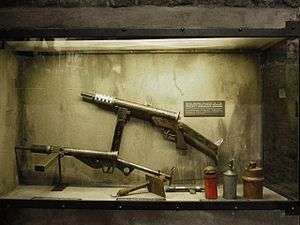
The Polish resistance was provided with numerous Stens of various models by the SOE and the Cichociemni. Between 1942 and 1944, approximately 11,000 Sten Mk IIs were delivered to the Armia Krajowa. Due to the simplicity of design, local production of Sten variants was started in at least 23 underground workshops in Poland. Some of them produced copies of Mark IIs, while others produced the so-called Polski Sten and KIS. The Polski Stens made in Warsaw under the command of Ryszard Białostocki were built from a number of "legal" elements made in official factories or acquired through other means. The main body of the machine pistol was made from hydraulic cylinders produced for hospital equipment. All the machine pistols were marked in English to disguise their origin. Stens' barrels were also used for SMGs produced in Poland under the name Błyskawica.
Belgian Sten MkII
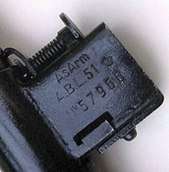
A little known version of the MkII Sten was built in Belgium by l'arsenale militare belga (the Belgian military arsenal). The magazine well was stamped AsArm (the manufacturer), ABL (for Armée Belge Belgisch Leger), the Belgian Royal Crown and a serial number of typically five figure with no letter prefix. It is believed the Belgian built Mk II Stens remained in ABL service until the early 1980s, particularly with helicopter-borne forces. Some of the weapons had a "Parkerised" finish.
Gerät Potsdam
In late 1944, the Mauser works in Germany secretly started manufacturing copies of the Mk II Sten. These weapons were intended to duplicate the British original as closely as possible, including the markings. The series was referred to as the Gerät Potsdam (Potsdam Device)[24] and approximately 28,000 weapons were made – even though the Germans had ample stocks of captured original Stens available.
German MP 3008

Late in the war Germany was seeking a cheap version of the MP40 machine pistol for the Volkssturm. For that purpose a modified Sten was designed by Mauser and named the MP 3008.[24] The main difference was the magazine attached below the weapon. Altogether, roughly 10,000 were produced in early 1945, just before the end of World War II.
Austen submachine gun
The Mark I Austen (from "Australian Sten") was a 9mm Australian submachine gun derived from the British Sten gun developed during the Second World War by the Lithgow Small Arms Factory. It externally resembled the Sten but had twin pistol grips and folding stock resembling those of the German MP40.[25] A Mk 2 version was also produced which was of different appearance and which made more use of die-cast components.[26] 20,000 Austens were made during the war and the Austen was replaced by the F1 submachine gun in the 1960s.[25]
Imperia submachine gun
After the Second World War the Belgian Army was mainly equipped with a mixture of British and American submachine guns. The army, wanting to replace them with a modern and preferably native design, tested various designs with the Vigneron M2 and licence-produced FN Uzi being selected. However, the Imperia was an improved Sten with a fire selector and retractable stock.
Sputter Gun
A short-lived American invention developed in the 1980s, the Sputter Gun was designed to circumvent the law that defined a machine gun as something that fired multiple rounds with one pull of the trigger. The Sputter Gun had no trigger, but fired continuously after loading and the pulling back of its bolt, firing until it ran out of ammunition. The gun was very short lived as the ATF quickly reclassified it.
Halcon ML-57
The Halcon ML-57 was a simpler derivative of the Sten gun of Argentine origin that was fed from a vertically inserted magazine.
International Ordnance MP2
During the 1970s-1980s, International Ordnance of San Antonio, Texas, United States released the MP2 machine pistol. It was intended as a more compact, simpler derivative of the British Sten gun to be used in urban guerrilla actions, to be manufactured cheaply and/or in less-than-well-equipped workshops and distributed to "friendly" undercover forces. Much like the FP-45 Liberator pistol of World War II, it could be discarded during an escape with no substantial loss for the force's arsenal. The MP2 is a blowback-operated weapon that fires from an open bolt with an extremely high rate of fire.
Cellini Dunn SM-9
The SM-9 is a machine pistol of Guatemalan origin and manufactured by Cellini-Dunn IMG, Military Research Corp and Wildfire Munitions as the SM-90. It is blowback operated, firing from an open bolt and can use magazines from Ingram MAC-10 submachine guns inserted into a similar foregrip that can be rotated 45 and 90 degrees for left/right handed operators. The layout of the receiver is somewhat simpler than that of a Sten with its internal components light in weight enabling a very high rate of fire of 1200rpm. Its forward pistol grip can hold a spare magazine as well as handling the weapon when firing.
Pleter 91
The Pleter submachine gun was created in 1991 when the breakup of Yugoslavia in the midst of emerging war left the newly formed Republic of Croatia with small number of military firearms. Since the embargo prevented the Croatian military from legally buying them on open market (so they were mostly obtained on the world black market, but with significantly higher price and sometimes of questionable quality), to fulfill the immediate need for arms, they tried to resort on quick and simple locally made designs.
Despite having a vertical magazine well (designed to accept 32-round double-feed direct copy of UZI magazine, rather than original single-feed Sten-type magazine), analogies with the Sten include a striking resemblance in the barrel assembly and in the bolt and recoil spring. In addition, this gun also fires from an open bolt, and is further simplified by removing fire mode selector or any safety.
SaskSten
SMG International in Canada manufactured reproductions of the Sten in six variants. They made copies of the Sten's Mk 1*, Mk II and Mk III, a "New Zealand Sten" (a Mk II/III Sten hybrid, with sights and a fixed magazine housing similar to the Mk III), then branched out into "hypothetical" Sten-guns with a "Rotary Magazine Sten" (a Mk II Sten with a drum magazine attached below the weapon and wooden horizontal forward grip on the left side of the weapon) and the "FRT Gun" (a long barrel Sten with a wooden or Mk 1* type butt stock, a drum magazine attached below the weapon and sliding ramp rear sights). These last two being obviously not Sten reproductions, especially if they included a drum magazine.[27] The "Rotary Magazine Sten" is a vertically fed Sten which uses a modified Sten bolt, which can use either PPSh drum magazines or stick magazines. The FRT gun is essentially a Suomi that uses a Sten trigger mechanism. All SaskSten guns fire from an open bolt.[28]
Service
The Sten, especially the Mark II, tended to attract affection and loathing in equal measure. Its peculiar appearance when compared to other firearms of the era, combined with sometimes questionable reliability made it unpopular with some front-line troops.[29] It gained nicknames such as "Plumber's Nightmare", "Plumber's Abortion", or "Stench Gun". The Sten's advantage was its ease of mass-production manufacture in a time of shortage during a major conflict.
Made by a variety of manufacturers, often with subcontracted parts, some early Sten guns were made poorly and/or not made to specification, and could malfunction in operation, sometimes in combat.[30] The double-column, single-feed magazine copied from the German MP28 was never completely satisfactory, and hasty manufacturing processes often exacerbated misfeed problems inherent in the design. A common statement heard from British forces at the time was that the Sten was made "by Marks and Spencer out of Woolworth."[31] British and Commonwealth forces in the early years of the war often extensively test-fired their weapons in training to weed out bad examples; a last-minute issue of newly manufactured Stens prior to going into action was not always welcomed.
The MK II and MK III Stens were regarded by many soldiers as very temperamental, and could accidentally discharge if dropped or even laid on the ground whilst the gun was cocked.[31] Others would fire full-automatic when placed on 'single', or fire single shots when placed on 'automatic'.[31] This was particularly true of early Stens using bronze bolts, where the sear projection underneath the bolt could wear down more easily than ones made of case-hardened steel.
Stens could jam at inopportune moments. One of the more notable instances of this was the assassination of SS-Obergruppenführer Reinhard Heydrich on 27 May 1942, when a Czechoslovak soldier – Warrant Officer Jozef Gabčík – wanted to fire his Sten point blank at Heydrich, only to have it misfire. His comrade Jan Kubiš then hastily tossed a grenade, which mortally wounded Heydrich.[30] There are other accounts of the Sten's unreliability, some of them true, some exaggerated and some which are apocryphal. France[32] manufactured (well-made) Sten copies postwar into the early 1950s, evidently believing in the basic reliability and durability of the design.
A well-maintained (and properly functioning) Sten gun was a devastating close-range weapon for sections previously armed only with bolt-action rifles. In addition to regular British and Commonwealth military service, Stens were air-dropped in quantity to resistance fighters and partisans throughout occupied Europe. Due to their slim profile and ease of disassembly/reassembly, they were good for concealment and guerrilla warfare. Wrapping the barrel in wet rags would delay undesirable overheating of the barrel.[33] Guerrilla fighters in Europe became adept at repairing, modifying and eventually scratch-building clones of the Sten (over 2,000 Stens and about 500 of the similar Błyskawica SMGs were manufactured in occupied Poland).

Canadian infantry battalions in northwest Europe retained spare Sten guns for special missions and the Canadian Army reported a surplus of the weapons in 1944. The Sten saw use even after the economic crunch of World War II, replacing the Royal Navy's Lanchester submachine guns into the 1960s, and was used in the Korean War, including specialist versions for British Commandos. It was slowly withdrawn from British Army service in the 1960s and replaced by the Sterling SMG; Canada also phased out the Sten, replacing it with the C1 SMG.
The Sten was one of the few weapons that the State of Israel could produce domestically during the 1948 Arab–Israeli War. Even before the declaration of the State of Israel, the Yishuv had been producing Stens for the Haganah; after the declaration, Israel continued making Stens for IDF use. The opposing side also used (mostly British-made) Stens, particularly the irregular and semi-regular Arab Liberation Army.[34]
In the 1950s "L numbering" came into use in the British Army for weapons—Stens were then known as L50 (Mk II), L51 (Mk III) and L52 (Mk V).
One of the last times the Sten was used in combat during British service was with the RUC during the IRA border campaign of 1956–1962. In foreign service, the Sten was used in combat at least as recently as the Indo-Pakistani War of 1971.
In 1971 various marks of Stens were used by guerilla fighters during the Bangladesh Liberation War.
A number of suppressed Stens were in limited use by the US Special Forces during the Vietnam war, including c. 1971, by the United States Army Rangers.[35]
In 1984, Indian prime minister Indira Gandhi was assassinated by two of her bodyguards, one of whom fired the entire magazine (30 rounds) of his Sten at point-blank range, of which 27 hit her.
In the Second Sino-Japanese War and the Chinese Civil War, both nationalists and communists used the Sten. Some Stens were converted by the communists to 7.62×25mm[17] by using the magazine housing from a PPS to accept curved PPS magazines. British, Canadian, and Chinese Stens were seen in the hands of the communists during the Korean and Vietnam Wars.[17]
The Finnish Army acquired moderate numbers of Stens in the late 1950s, mainly Mk. III versions. Refurbishment at the Kuopio Arsenal included bluing of the arms. Stens in Finnish service saw limited usage by conscripts (notably combat swimmers) and were mostly stockpiled for use in a future mobilization.
During the Zapatista movement in 1994 some Zapatista soldiers were armed with Sten guns.[36]
Users



.svg.png)


.svg.png)
.svg.png)

.svg.png)
.svg.png)


















.svg.png)
.svg.png)





.svg.png)







.svg.png)

.svg.png)






.svg.png)
.svg.png)
Non-state groups
- The Provisional IRA and Official IRA [86]
- The Ulster Volunteer Force and Ulster Freedom Fighters [86]
- Balcombe Street Gang[86]
- The Angry Brigade[86][87][88]
Gallery
 British paratrooper with Sten Mk II in October 1942
British paratrooper with Sten Mk II in October 1942.jpg) Sten Mk II—bolt is not cocked
Sten Mk II—bolt is not cocked.jpg) Sten Mk II—bolt is not cocked
Sten Mk II—bolt is not cocked- Sten Mk II—dorsal view. Bolt is not cocked
.jpg) Sten Mk II—detail of rear sight
Sten Mk II—detail of rear sight Sten Mk II—detail of magazine well and foresight
Sten Mk II—detail of magazine well and foresight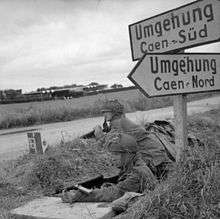 British Paratroops with Sten Mk Vs on D-Day+1
British Paratroops with Sten Mk Vs on D-Day+1 Canadian soldier holding Sten Mk II guards German prisoners captured at Juno Beach on D-Day, 6 June 1944
Canadian soldier holding Sten Mk II guards German prisoners captured at Juno Beach on D-Day, 6 June 1944- Hispano Argentina Sten gun. Note the 'Ballester Molina' type trigger section.
 Sten MKIII
Sten MKIII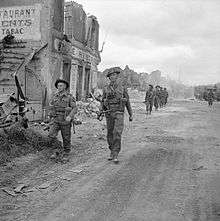 Men of 'A' Company, 6th Durham Light Infantry, 50th Division, in the village of Douet (Grandcamp-Maisy), 11 June 1944
Men of 'A' Company, 6th Durham Light Infantry, 50th Division, in the village of Douet (Grandcamp-Maisy), 11 June 1944 Close-up of a suppressed Sten (at the top of the photo) on display at the Imperial War Museum
Close-up of a suppressed Sten (at the top of the photo) on display at the Imperial War Museum French Resistance members captured by Milice in July 1944. The man on the left carries a captured Sten Mk II
French Resistance members captured by Milice in July 1944. The man on the left carries a captured Sten Mk II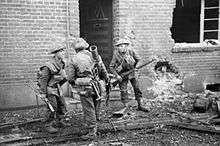 British infantry in action on the streets of Geilenkirchen, Germany during Operation Clipper, December 1944
British infantry in action on the streets of Geilenkirchen, Germany during Operation Clipper, December 1944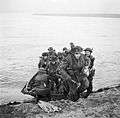 Men of the 15th Scottish Division leave their assault craft after crossing the Rhine on 24 March 1945
Men of the 15th Scottish Division leave their assault craft after crossing the Rhine on 24 March 1945 A British soldier from 11th Armoured Division guards two German prisoners with a Sten Mk III on 7 April 1945
A British soldier from 11th Armoured Division guards two German prisoners with a Sten Mk III on 7 April 1945

 The Monumento al Partigiano in Parma (Italy)
The Monumento al Partigiano in Parma (Italy) Yugoslav partisan from Montenegro with Sten (March 1945)
Yugoslav partisan from Montenegro with Sten (March 1945)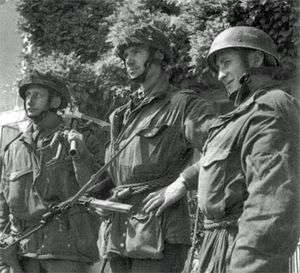 British troops after capturing Pegasus Bridge, June 1944. Photo shows a Sten Mk V with bayonet.
British troops after capturing Pegasus Bridge, June 1944. Photo shows a Sten Mk V with bayonet.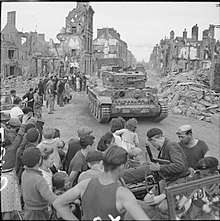 Sten Mk III in the foreground as Cromwell tanks pass through Flers in August 1944
Sten Mk III in the foreground as Cromwell tanks pass through Flers in August 1944
References
- Bloomfield & Leiss 1967, p. 89.
- "Contre les Mau Mau". Encyclopédie des armes : Les forces armées du monde (in French). XII. Atlas. 1986. pp. 2764–2766.
- "L'armement français en A.F.N." Gazette des Armes (in French). No. 220. March 1992. pp. 12–16.
- Bloomfield & Leiss 1967, p. 191.
- McNab, Chris (2002). 20th Century Military Uniforms (2nd ed.). Kent: Grange Books. p. 185. ISBN 978-1-84013-476-6.
- "Arms for freedom". 29 December 2017. Retrieved 31 August 2019.
- "Variety of Iraq weapons astounds expert". Stars and Stripes.
- http://www.model-engineer.co.uk/sites/7/images/member_albums/77123/585369.jpg : Model Engineer Volume 88 Issue 2195 P.509 The STEN Carbine, A Description
- Not all sources agree. Colonel Shepherd discussing how it was named when he received an Award from the Board of the Royal Commission Awards to Inventors. Lord Cohen: "Why was it called the Sten?" Colonel Shepard: "It was called the Sten by the then Director General of Artillery. The S was from my name, the T from Mr. Turpin who was my draughtsman and who did a very large amount of the design and the EN was for England. That is the origin of the name, for which I accept no responsibility." In: Laidler, Peter (2000). The Sten Machine Gun. Ontario: Collector Grade Publications. pp. 363–364. ISBN 978-0-88935-259-9. In the official history of the Royal Ordnance Factories, ST is for Shepard and Turpin and EN is for Enfield. In: Ian Hay (Maj.-Gen. John Hay Beith, CBE, MC) (1949). R.O.F. The Story of the Royal Ordnance Factories, 1939–1948. London: His Majesty's Stationery Office. Some sources give J.J.Turpin rather than Harold
- Hastings, Max (2013) [1981]. Das Reich: The March of the 2nd SS Panzer Division through France, June 1944 (2 ed.). Minneapolis, USA: Zenith Press. p. 237. ISBN 978-0-7603-4491-0.
- Carbine, Machine, STEN 9mm Mk II, General Instructions, (February 1942) Manual: Heavy carbon buildup could prevent the firing pin from detonating the primer.
- Carbine, Machine, STEN 9mm Mk II, General Instructions, (February 1942)
- Dunlap, Roy F., Ordnance Went Up Front, Samworth Press (1948), p. 80
- D Cuthbertson. "infantry-weapons.org". infantry-weapons.org. Archived from the original on 22 May 2009. Retrieved 9 June 2009.
- Skennerton, Ian (September 1988). British Small Arms of World War 2: The Complete Reference Guide to Weapons, Codes and Contracts, 1936-1946. Greenhill Books. p. 32. ISBN 978-0-949749-09-3.
- The barrel sleeve was generally considered the proper place for the supporting hand, as holding the weapon by its magazine could sometimes initiate a feed malfunction. However, the metal barrel sleeve heated rapidly after only a few bursts.
- "Stens of the World: Part I". Small Arms Defense Journal.
- Wolfgang Michel: Britische Schalldämpferwaffen 1939-1945: Entwicklung, Technik, Wirkung. ISBN 978-3-8370-2149-3
- "Silencedsten". 96.lt.
-
- Julio S. Guzmán, Las Armas Modernas de Infantería, Abril de 1953.
- "Museo de armas de la Nación (Buenos Aires), 2011". flickr.com. 21 January 2011.
- "Sten Mk 2 type submachine-gun [Jewish underground]". Imperial War Museums.
- Manus, Max, Part I, Det vil helst gå godt (It'd best be all right); Part II, Det blir alvor (It gets serious), Familieforlaget (1946), ISBN 978-82-8214-043-0
- Smith 1969, p. 429.
- Smith, Joseph E. (1969). Small Arms of the World (11 ed.). Harrisburg, Pennsylvania: The Stackpole Company.CS1 maint: ref=harv (link)
- Smith 1969, p. 200.
- "SMG International Sten SaskSten FRT Gun". archive.org. 29 November 2010. Archived from the original on 29 November 2010.
- Mick Boon
- Weeks, John, World War II Small Arms, Galahad Books (1979), ISBN 0-88365-403-2, p. 84
- Willbanks, James H., Machine Guns: An Illustrated History of Their Impact, ABC-CLIO Press (2004), ISBN 1-85109-480-6, ISBN 978-1-85109-480-6, p. 91
- Shore, C. (Capt), With British Snipers to the Reich, Paladin Press (1988), p. 208-209
- "Oddities". archive.org. 16 July 2004. Archived from the original on 16 July 2004.
- Dear, I. Sabotage and Subversion: The SOE and OSS at War, Arms and Armour (1996) p. 137–155
- Morris, Benny (2008). 1948: A History of the First Arab-Israeli War. Yale University Press. ISBN 978-0-300-12696-9.
- "The Vietnam Experience LRRP 1966-1972". 25thaviation.org. Retrieved 9 June 2009.
- Oppenheimer, Andrés (8 February 1994). "Deep in the heart of Mayan Mexico, a revolution that's out of this world". Rome News-Tribune. Rome, Georgia, USA. Retrieved 21 April 2014.
- Thompson 2012, pp. 50-51.
- Fitzsimmons, Scott (November 2012). "Callan's Mercenaries Are Defeated in Northern Angola". Mercenaries in Asymmetric Conflicts. Cambridge University Press. p. 155. doi:10.1017/CBO9781139208727.005. ISBN 9781107026919.
- Thompson 2012, p. 73.
- Thompson 2012, p. 16.
- Kalam, Zaid (29 December 2017). "Arms for freedom". The Daily Star.
- "Google Sites". sites.google.com.
- Bonn International Center for Conversion; Bundeswehr Verification Center. "Sten MP". SALW Guide: Global distribution and visual identification. Retrieved 31 August 2018.
- "STEN SMG". Military Factory. Retrieved 4 June 2014.
- Berman, Eric G.; Lombard, Louisa N. (December 2008). The Central African Republic and Small Arms: A Regional Tinderbox (PDF). Small Arms Survey. pp. 35, 43. ISBN 978-2-8288-0103-8.
- Abbot, Peter (February 2014). Modern African Wars: The Congo 1960–2002. Oxford: Osprey Publishing. p. 15. ISBN 978-1782000761.CS1 maint: ref=harv (link)
- Abbot 2014, p. 14.
- Thompson 2012, p. 67.
- Weyman, Bay. "Finding Fidel: The Journey of Erik Durschmied". TV Ontario. Archived from the original on 14 July 2014. Retrieved 16 June 2014.
- Thompson 2012, p. 60.
- https://www.forgottenweapons.com/chinese-7-62mm-sten-gun/
- Thompson 2012, pp. 51-52.
- Thompson 2012, pp. 52-53.
- Smith 1969, pp. 613&615.
- Palokangas, Markku (1991): Sotilaskäsiaseet Suomessa 1918-1988 III osa Ulkomaiset aseet. Vammalan Kirjapaino Oy. P.191 ISBN 951-25-0519-3
- Thompson 2012, p. 45.
- Cullen, Stephen M. (2018). World War II Vichy French Security Troops. Men-at-Arms 516. Osprey Publishing. pp. 42–43. ISBN 978-1472827753.
- Windrow, Martin (15 November 1998). The French Indochina War 1946–54. Men-at-Arms 322. Osprey Publishing. p. 41. ISBN 9781855327894.CS1 maint: ref=harv (link)
- Thompson 2012, p. 69.
- "Urgent Fury 1983: WWII weapons encountered". wordpress.com. 18 October 2015.
- Smith 1969, p. 461.
- Russell, Lee; Katz, Sam (April 1986). Israeli Defense Forces, 1948 to the Present. Uniforms Illustrated 12. Olympic Marketing Corp. p. 15. ISBN 978-0853687559.
- Thompson 2012, p. 6.
- Young, Peter (1972). The Arab Legion. Men-at-Arms. Osprey Publishing. p. 24. ISBN 978-0-85045-084-2.
- "World Infantry Weapons: Libya". Archived from the original on 5 October 2016.
- "Legacies of War in the Company of Peace: Firearms in Nepal" (PDF). Nepal Issue Brief. Small Arms Survey (2): 4. May 2013.
- Bloomfield, Lincoln P.; Leiss, Amelia Catherine (30 June 1967). The Control of local conflict : a design study on arms control and limited war in the developing areas (PDF). 3. Massachusetts Institute of Technology. Center for International Studies. p. 79. hdl:2027/uiug.30112064404368.
- Thompson, Leroy (20 September 2012). The Sten Gun. Osprey Publishing. p. 70. ISBN 978-1-78096-125-5.CS1 maint: ref=harv (link)
- Thompson 2012, p. 71.
- Thompson 2012, p. 25.
- Smith 1969, p. 523.
- Mallet, N. H. (9 December 2013). "The Venerable Sten – The Allies' $10 Dollar Submachine Gun". Military History Now. Retrieved 22 March 2014.
- Thompson 2012, p. 9.
- Thompson 2012, p. 56.
- Smith 1969, p. 530.
- Moorcraft, Paul; McLaughlin, Peter (2008). The Rhodesian War: A Military History. Jonathan Ball Publishers. p. 92. ISBN 978-1-86842-330-9.
- "World Infantry Weapons: Sierra Leone". 2013. Archived from the original on 24 November 2016.
- "SOUTH AFRICA: The Sharpeville Massacre". Time. 4 April 1960.
- Shakya, Tsering (1999). The Dragon in the Land of Shows: A History of Modern Tibet Since 1949. Columbia University Press. pp. 5–6, 8–9, 11–15, 26, 31, 38–40.
- Thompson 2012, p. 4.
- Windrow 1998, p. 24.
- Chris Bishop (1996). Vital Guide to Combat Guns and Infantry Weapons. p. 203. ISBN 978-1853105395.
- Scarlata, Paul (1 October 2017). "Yugoslav Part II: World War II small arms: an assortment of small arms from friends and foe alike". Firearms News.
- Vukšić, Velimir (July 2003). Tito's partisans 1941–45. Warrior 73. Osprey Publishing. pp. 24–25. ISBN 978-1-84176-675-1.
- Smith 1969, p. 723.
- Christopher Dobson; Ronald Payne (1982). The Terrorists: Their Weapons, Leaders, and Tactics. Facts on File. pp. 101–103.
- Gordon Carr (2010). The Angry Brigade: A History of Britain's First Urban Guerilla Group. PM Press. p. 98. ISBN 978-1604860498.
- Gianfranco Sanguinetti (2015). Red Army Faction. Red Brigades, Angry Brigade. The Spectacle of Terror in Post War Europe. Bread and Circuses.
External links
| Wikimedia Commons has media related to: |
- "Sten Gun to be forerunner of invasion" September 1943 detailed article in Popular Science
- Complete machinist's plans to manufacture a Sten Mk II
- Sten at Modern Firearms